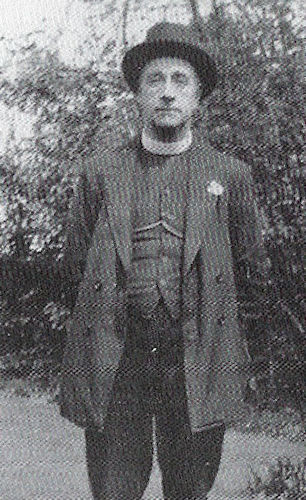Herbert, who was born in 1915, followed his father’s example and was in the choir for 70 years from the age of 7 and a bellringer from the age of 12. He loved singing and used to sing all day when working at Slades Garage. There was no electricity in the church until 1938 and he was a candle boy responsible for the nine candles on the candelabra over the chancel step and on the altar, lighting them with a taper on a long arm and putting them out after the service. Oil lamps were lit by Mr Busby. The organ was between the Lady Chapel and the choir stalls and was powered by bellows which were pumped manually by a handle behind the organ with a floating indicator to tell you whether more air was needed. Heating was a tortoise stove. Earl Howe’s pew was still in the chancel with red cushions.
He just remembers Mr Kerby, who was the Vicar from 1898 to 1922. He had a nanny goat beard, and, so he was told, used to bash the pulpit if people slept during his sermon. He remembers a sixth bell being installed in the tower to mark the signing of the Peace Treaty in 1919. Herbert was there for the licensing of the next Vicar in 1922, the Rev. Ernest Smith, a nice man, he remembered, but he didn’t go down too well with many of the parishioners because he was so High Church, replacing the communion table with an altar and using incense. The congregation dropped off. (See Altar Arrangements, Part 4)
In 1937, the Rev. Smith retired and a new Vicar, Kenneth Mumford, arrived. Herbert had already met him as a boy when, as Vicar of Coleshill, he was their religious studies teacher at the Penn Church school. He remembers a biggish man who drove a little Austin 7, and recalls, ‘he was a remarkable man. You could hear a pin drop when he stood on the chancel steps to give a sermon. No notes’. He energised the congregation, started the Parish Magazine which has continued to this day, raised large sums for much-needed repairs, installed electric light and water and played an important part in the discovery of the Doom painting. Herbert told me that a good many pieces were found in the dell used as a parish rubbish dump in the field off Gravelly Way, opposite what is now known as Lions Farm.
Unhappily, Kenneth Mumford died of lung trouble after only 15 months. He was always very short of breath, which Herbert attributes to a result of gassing in the First War, and is buried with his wife, a former ballet dancer, at Coleshill.
It is extraordinary to have a first-hand witness to these events of nearly 100 years ago and I am very grateful that Herbert Druce is still with us to provide them.
© Miles Green, May 2015

